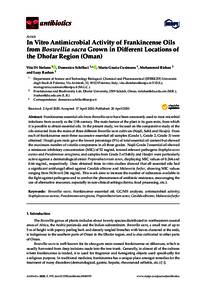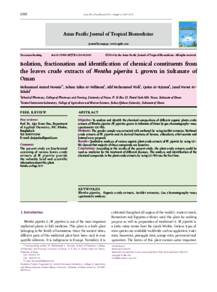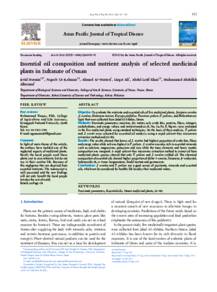Document
In vitro antimicrobial activity of frankincense oils from boswellia sacra grown in different locations of the Dhofar region (Oman).
Identifier
DOI: 10.3390/antibiotics9040195
Source
Antibiotics. v. 9, 4, 195
Contributors
Schillaci, Domenico., Author
Cusimano, Maria Grazia., Author
Rishan, Mohammed., Author
Rashan, Luay., Author
Country
Switzerland
Publisher
MDPI AG.
Gregorian
2020-04-01
Language
English
Subject
English abstract
Frankincense essential oils from Boswellia sacra have been commonly used to treat microbial infections from as early as the 11th century. The main feature of the plant is its gum resin, from which it is possible to obtain essential oils. In the present study, we focused on the comparative study of the oils extracted from the resins of three different Boswellia sacra cultivars (Najdi, Sahli and Houjri). From each of frankincense resin three successive essential oil samples (Grade 1, Grade 2, Grade 3) were obtained. Houjri gum resin gave the lowest percentage (5%) of total essential oil content but showed the maximum number of volatile components in all three grades. Najdi Grade 2 essential oil showed a minimum inhibitory concentration (MIC) of 52 mg/mL toward relevant pathogens Staphylococcus aureus and Pseudomonas aeruginosa, and samples from Grade 2 of Sahily and Houjiri were particularly active against a dermatological strain Propionibacterium acnes, displaying MIC values of 0.264 and 0.66 mg/mL, respectively. Data obtained from in vitro studies showed that all essential oils had a significant antifungal effect against Candida albicans and Malassezia furfur, showing MIC values ranging from 54.56 to 0.246 mg/mL. This work aims to increase the number of substances available in the fight against pathogens and to combat the phenomenon of antibiotic resistance, encouraging the use of alternative resources, especially in non-clinical settings (farms, food processing, etc.).
ISSN
2079-6382
Resource URL
Category
Journal articles




